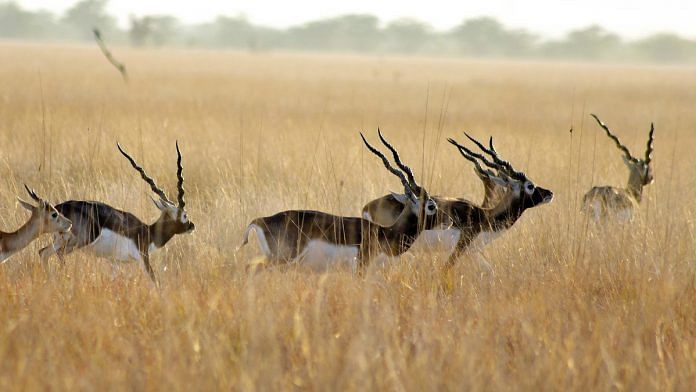New Delhi: After two weeks of heated debate, over 190 countries including India adopted a landmark agreement Monday to “halt and reverse” the unprecedented decline in biodiversity that has already pushed 1 million species to the verge of extinction.
Titled the Kunming-Montreal Global Biodiversity Framework, the agreement includes 23 targets to protect nature and was adopted at the 15th Conference of Parties to the UN Convention on Biological Diversity, which concluded Monday. The targets aim to cut subsidies considered harmful to biodiversity by $500 billion a year, reduce the introduction of alien invasive species by 50 per cent, and “bring the loss of areas of high biodiversity importance, including ecosystems of high ecological integrity, close to zero” by 2030.
The agreement also adopted the headlining target to ensure at least 30 per cent of terrestrial, inland water, and coastal and marine areas of “particular importance for biodiversity are effectively conserved and managed” by 2030.
The COP15 biodiversity summit took place between 6 and 19 December in Montreal.
The adoption of the agreement was not smooth, with at least four African countries expressing disagreement over the text, particularly with regard to the financial arrangements for the biodiversity agreement.
Halting biodiversity loss and restoring degraded ecosystems are considered vital to mitigating the effects of climate change. The latest edition of the Global Biodiversity Outlook report by the Intergovernmental Science-Policy Platform on Biodiversity and Ecosystem Services (IPBES) pegged the number of species threatened by extinction at 1 million, warning that the current rate of extinction is “at least tens to hundreds of times higher than it has averaged over the past 10 million years”.
Limiting global warming will not be possible without forest conservation, the Intergovernmental Panel on Climate Change, a body of the United Nations, has said. The Global Biodiversity Framework, which is being likened to the 2015 Paris Agreement on climate change, aims to “implement broad-based action to bring about a transformation in our societies’ relationship with biodiversity by 2030, in line with the 2030 Agenda for Sustainable Development and its Sustainable Development Goals”.
In a late-night blog post Monday, India’s Union environment minister Bhupender Yadav said: “The suggestions from India to keep all the goals and targets, globally, were accepted, along with other propositions. India’s pitch for LiFE, Lifestyle for Environment, and common but differentiated responsibilities and respective capabilities found an echo in the GBF.”
India launched the LiFE Mission earlier this year with the aim to promote healthy lifestyles globally. One of the targets in the agreement is to “ensure people are encouraged and enabled to make sustainable consumption choices”, with the aim to reduce the global footprint of consumption and waste generation in an equitable manner by 2030.
By 2050, the agreement hopes to reduce the rate of extinction and risk to species 10-fold, while “substantially increasing the area of natural ecosystems.”’
Also Read: ‘Global double emergency’: WWF highlights ‘devastating’ loss of biodiversity in new report
Biodiversity funding
The 14-page Framework document spans targets to do with the equitable sharing of genetic resources, the protection of indigenous rights over protected areas, as well as the need to fill the finance gap for biodiversity conservation.
The framework seeks to ensure that the loss of areas of high biodiversity importance arising from changes in land and sea use are brought “close to zero” by 2030.
Another target includes reducing pollution risks to biodiversity to levels that are “not harmful” to biodiversity, such as cutting risks from pesticides and highly hazardous chemicals by at least half, by 2030.
During talks, some of these targets were contested by developing countries, including India, which contended that a “one size fits all” approach isn’t acceptable.
On Sunday, Yadav made an intervention at a stocktaking plenary meeting a day before the talks were set to conclude, saying that for developing nations, “agriculture is a paramount economic driver for rural communities, and the critical support provided to these sectors cannot be redirected”.
“When food security is of paramount importance for developing countries, prescribing numerical targets in pesticide reductions is unnecessary and must be left to countries to decide, based on national circumstances, priorities and capabilities,” he had said at the plenary session.
Negotiations were also made tense over funding for biodiversity. Days before the talks concluded, developing countries, including India, staged a walkout during talks on finance, claiming rich countries were not willing to commit to a robust package.
Developing countries had demanded a new fund dedicated to implementing the framework, but this was opposed by developed countries, who argued funding should continue through existing mechanisms.
So far, the Global Environment Facility, which also caters to other conventions like the UN Climate Convention, is the only fund for biodiversity.
According to the Kunming-Montreal Global Biodiversity framework, there is a biodiversity finance gap of $700 billion a year, and it endeavors to mobilise $200 billion in biodiversity financing a year through existing mechanisms. It also opens the door to discussing separate funding arrangements in future conventions.
Agreement to the framework will be subject to planning and monitoring, according to the document. Countries are expected to come up with and follow national biodiversity strategies and action plans in line with the framework.
(Edited by Uttara Ramaswamy)
Also Read: GDP doesn’t capture full value of nature — global green panel wants development ‘redefined’



